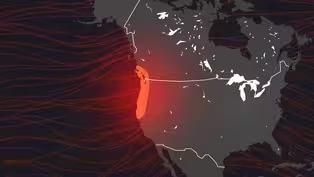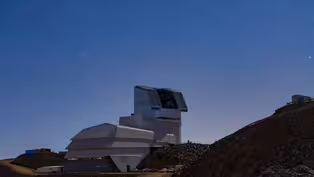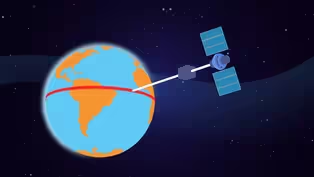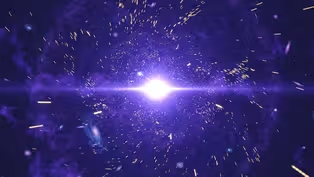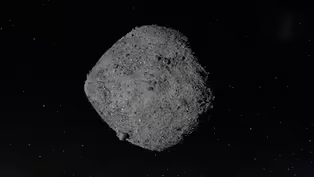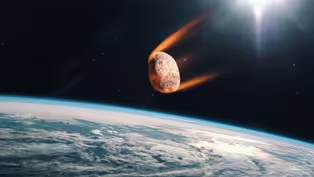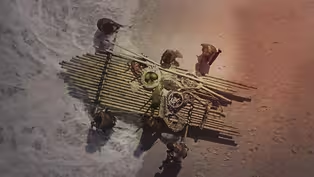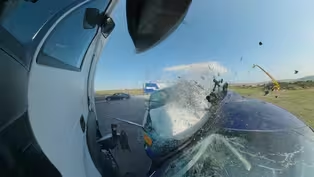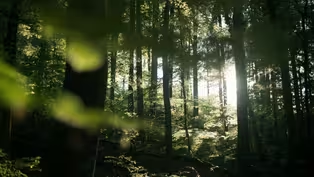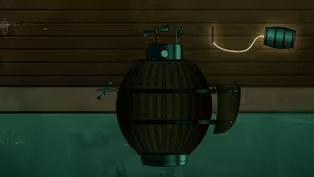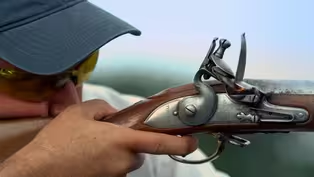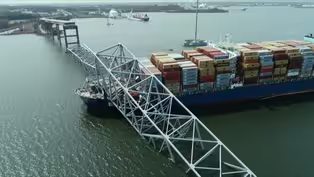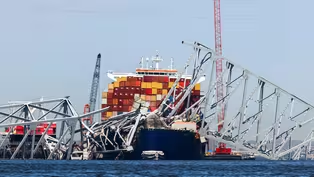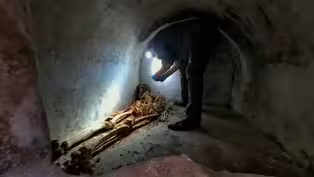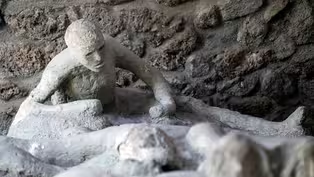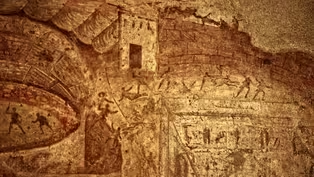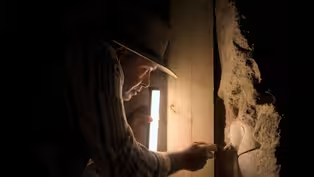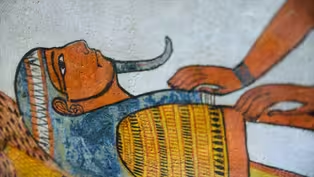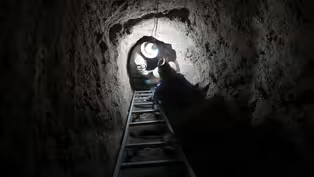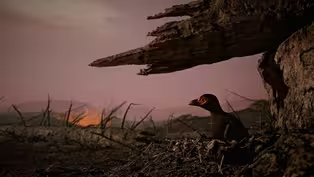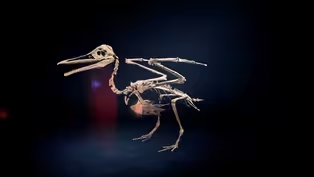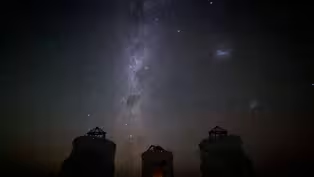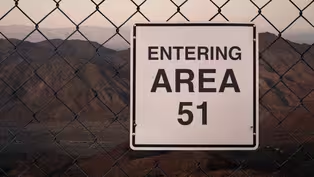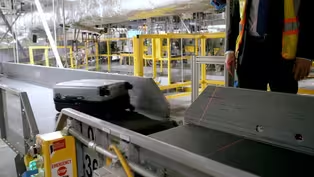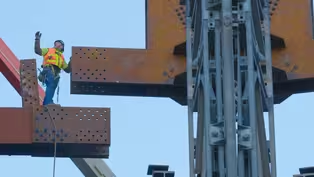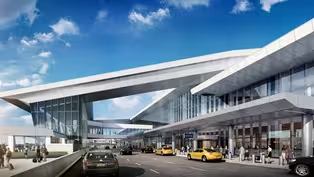
The Next Big Earthquake Could Sink Parts of the Pacific Northwest
Clip: Season 52 | 5m 8sVideo has Closed Captions
A massive earthquake along the Cascadia Subduction Zone could sink parts of the Pacific Northwest.
A 2025 study suggests that when the next "Big One" hits, coastal land could sink by up to 6 feet. That sudden drop could instantly double the number of people, homes, and roads exposed to flooding.
Problems playing video? | Closed Captioning Feedback
Problems playing video? | Closed Captioning Feedback
National Corporate funding for NOVA is provided by Carlisle Companies. Major funding for NOVA is provided by the NOVA Science Trust, the Corporation for Public Broadcasting, and PBS viewers.

The Next Big Earthquake Could Sink Parts of the Pacific Northwest
Clip: Season 52 | 5m 8sVideo has Closed Captions
A 2025 study suggests that when the next "Big One" hits, coastal land could sink by up to 6 feet. That sudden drop could instantly double the number of people, homes, and roads exposed to flooding.
Problems playing video? | Closed Captioning Feedback
How to Watch NOVA
NOVA is available to stream on pbs.org and the free PBS App, available on iPhone, Apple TV, Android TV, Android smartphones, Amazon Fire TV, Amazon Fire Tablet, Roku, Samsung Smart TV, and Vizio.
Buy Now
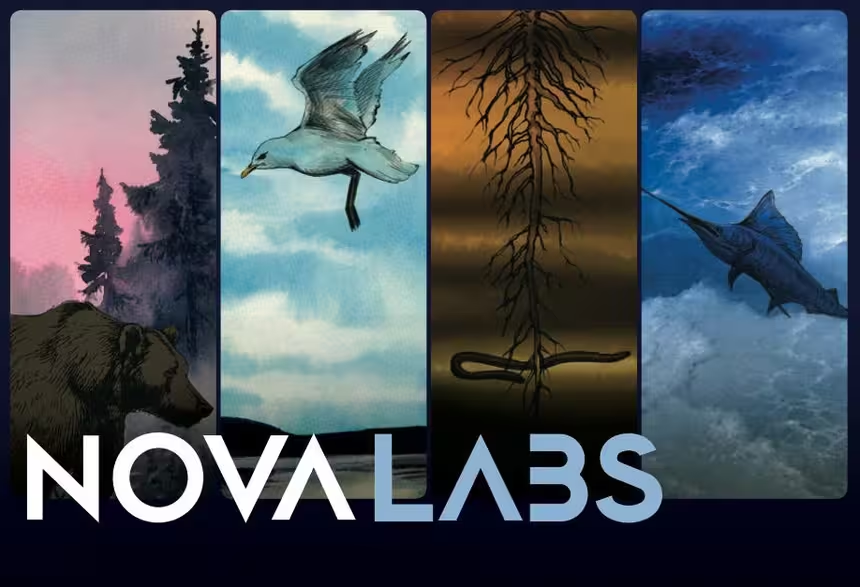
NOVA Labs
NOVA Labs is a free digital platform that engages teens and lifelong learners in games and interactives that foster authentic scientific exploration. Participants take part in real-world investigations by visualizing, analyzing, and playing with the same data that scientists use.Providing Support for PBS.org
Learn Moreabout PBS online sponsorship- [Narrator] In this region, a massive earthquake is pretty much inevitable.
This is the Cascadia Subduction Zone.
It's one of the top hazards on the planet.
Here, the ocean floor is slowly diving under North America.
Massive earthquakes are expected here every 500 years or so, and the last one was in 1700.
- [Wendy Bohon] So it's not a matter of if, it's just a matter of when.
- [Narrator] A 2025 study suggests that the quake could suddenly sink part of the Pacific Northwest and climate driven sea level rise would only make it worse.
So why is the Cascadia Subduction Zone so dangerous and when will the next big one happen?
The Cascadia Subduction Zone is a major fault line that spans Vancouver Island in Canada to Northern California, but it's not really a line at all.
It's a crack where two massive tectonic plates meet.
It's where one of the largest earthquakes in the history of North America happened more than 325 years ago.
in January of 1700.
The earthquake had an estimated magnitude of nine, and it caused a tsunami.
A graveyard of trees that fell victim to flooding are still in the area.
The subduction zone has been pretty quiet ever since.
The last magnitude nine earthquake on Earth was caused by a subduction zone known as the Japan Trench in 2011.
It spurred a tsunami and caused widespread devastation, including a nuclear disaster at the Fukushima Daiichi power plant.
Subduction zones produce the biggest earthquakes in the world.
They happen where one tectonic plate is sliding down another plate.
- [Wendy] In Cascadia, you have one plate diving down beneath another.
This section gets locked and it pushes this part up.
When the fault ruptures, when the amount of stress overcomes the friction, it bounces back, which lifts up the water above it and causes that water to flow out in all directions.
And that water flowing out in all directions is the tsunami.
- [Narrator] The inevitable earthquake in the Pacific Northwest is what's called "the big one," and it would absolutely be devastating to a number of coastal communities.
But the Cascadia Subduction Zone is not actually one continuous fault line.
It has ruptures in it that form at least four major segments.
It's possible that an earthquake in one zone might not trigger an earthquake in the others, but the longer the segment, the bigger the quake.
One segment runs from Vancouver Island to the Oregon border.
Some scientists think that this is the most dangerous section and could spark the biggest earthquakes.
So when will this happen?
Unfortunately, earthquakes often happen without any clear warning signs, and scientists haven't yet identified reliable predictors.
The United States Geological Survey even says that, "Neither the USGS nor any other scientists have ever predicted a major earthquake," and that they do not expect to know how to predict earthquakes in the foreseeable future.
Whoa.
Even if scientists can't predict when an earthquake will strike, they can use analytical models to study the potential effects.
Some researchers found that if the Cascadia earthquake were to strike today, the coastline could suddenly sink by up to six feet raising the sea level.
And more than doubling the number of people, buildings, and roads currently exposed to coastal flooding risks.
Sea levels are already rising across the globe.
But the Pacific Northwest coast has seen much slower rise than other parts of the US coastline because of the subduction zone.
It's slowly pushing the coastline up almost as fast as the sea level is rising in some areas.
But a massive earthquake could quickly reverse that.
According to one projection, by the year 2100 sea levels along the Pacific Northwest could rise by almost three feet.
Combined with a Cascadia quake, that's a sea level difference of nearly nine feet compared to today.
And don't forget that when the earthquake strikes, it will trigger a tsunami, which could bring waves over 50 feet high in some locations.
For now, some communities are taking action against these deadly threats by creating high ground.
A tsunami could come only 15 minutes after an earthquake, and experts say it's imperative to get to high ground ASAP.
The thing is that in many low lying coastal communities, that isn't an option.
So vertical evacuation structures like towers and platforms where people can get to high ground without traveling, great distances are essential.
Right now, there are three vertical evacuation towers in the Pacific Northwest, a tsunami evacuation tower built by the Shoalwater Bay Indian Tribe, an elementary school gym that was rebuilt with a fortified foundation to withstand massive earthquakes and a new roof built to hold more than a thousand people, and an Oregon State University marine sciences building.
There are more vertical evacuation structures planned for the Pacific Northwest, but one study found that many more are needed.
The trouble is we don't know how much time we have until the next big one.
(pensive music) Thanks for sticking around.
Don't forget to subscribe to see more videos from Nova, and click the bell icon to make sure you don't miss anything.
See you again soon.
The Next Big Earthquake Could Sink Parts of the Pacific Northwest
Video has Closed Captions
Clip: S52 | 5m 8s | A massive earthquake along the Cascadia Subduction Zone could sink parts of the Pacific Northwest. (5m 8s)
How Harvard Discovered It Has an Original Copy of the Magna Carta
Video has Closed Captions
Clip: S52 | 3m 13s | They paid only $27.50 for it from a London bookseller in 1946. (3m 13s)
This Giant Telescope Will Reveal The Universe in Unbelievable Detail
Video has Closed Captions
Clip: S52 | 5m 59s | Go behind the scenes as NOVA visits the Vera Rubin Observatory in Chile. (5m 59s)
The Science of Scratch-Offs: What Your Brain Can’t Resist
Video has Closed Captions
Clip: S52 | 6m 39s | You probably won’t win big playing the Lottery but your brain may want to keep trying. (6m 39s)
These Smart Glasses Know Who You Are, and Much More
Video has Closed Captions
Clip: S52 | 4m 18s | Two students created glasses that can identify people on the street, without them knowing. (4m 18s)
The Rocket-Less Future of Space Travel
Video has Closed Captions
Clip: S52 | 5m 17s | Space elevators? Nuclear rockets? The future of space travel could look radically different. (5m 17s)
Do Aliens Exist? This Famous Equation Offers a Clue
Video has Closed Captions
Clip: S52 | 5m 4s | The Drake Equation helps scientists estimate the odds of finding intelligent alien civilizations. (5m 4s)
Video has Closed Captions
Clip: S52 | 5m 7s | If the universe as we know it started with the Big Bang, will it also have an end? (5m 7s)
Building Blocks of Life Discovered on Distant Asteroid
Video has Closed Captions
Clip: S52 | 6m 3s | Scientists have discovered the building blocks of life in samples retrieved from a distant asteroid. (6m 3s)
This Asteroid Might Make Impact With Earth in 2032
Video has Closed Captions
Clip: S52 | 3m 33s | An asteroid is on a collision course with Earth, possibly making impact in 2032. (3m 33s)
Human: Building Empires Preview
Video has Closed Captions
Preview: S52 Ep16 | 30s | Discover how two revolutionary ancient inventions changed the course of humanity forever. (30s)
Human: Into the Americas Preview
Video has Closed Captions
Preview: S52 Ep15 | 30s | Follow ancient humans’ journey into an icy and perilous new land. (30s)
Human: Neanderthal Encounters Preview
Video has Closed Captions
Preview: S52 Ep14 | 30s | Discover how Homo sapiens outlasted Neanderthals – and how they helped make us who we are today. (30s)
Video has Closed Captions
Preview: S52 Ep13 | 30s | Follow Homo sapiens as they venture out of Africa and spread farther than any other human species. (30s)
Video has Closed Captions
Preview: S52 Ep12 | 30s | Trace the remarkable origin story of Homo sapiens and the crucial moments that shaped our species. (30s)
Ultimate Crash Test: Countdown Preview
Video has Closed Captions
Preview: S52 Ep10 | 30s | A first-of-its-kind experiment aims to stage a multi-vehicle pileup to gain new data on car safety. (30s)
Critical Condition: Health in Black America Preview
Video has Closed Captions
Preview: S52 Ep9 | 30s | After centuries of pseudoscience, researchers examine the causes of racial health disparities. (30s)
Why Just Planting Trees Won’t Save the Planet
Video has Closed Captions
Clip: S52 Ep8 | 3m 4s | Could restoring lost forests help slow climate change? (3m 4s)
Video has Closed Captions
Preview: S52 Ep8 | 30s | Follow scientists in a quest to understand how complex forest ecosystems can help cool our planet. (30s)
The World’s First Combat Submarine
Video has Closed Captions
Clip: S52 Ep7 | 10m 49s | Its nickname was the “Turtle”. (10m 49s)
Revolutionary War Weapons Preview
Video has Closed Captions
Preview: S52 Ep7 | 30s | Explore key military technologies in the American colonies’ fight for freedom. (30s)
Video has Closed Captions
Clip: S52 Ep7 | 4m 57s | A team of experts put an 18th-century musket to the test — revealing how deadly it really was. (4m 57s)
What Went Wrong on the Dali Before the Baltimore Bridge Collapse
Video has Closed Captions
Clip: S52 Ep6 | 2m 57s | The container ship Dali lost power causing it to crash into Baltimore’s Key Bridge. (2m 57s)
What Caused Baltimore’s Key Bridge to Collapse?
Video has Closed Captions
Clip: S52 Ep6 | 2m 57s | Engineers explain how a vulnerability made the bridge open to catastrophe. (2m 57s)
Baltimore Bridge Collapse Preview
Video has Closed Captions
Preview: S52 Ep6 | 30s | Follow the investigation into the deadly container ship collision that closed the Port of Baltimore. (30s)
This Pompeii Priest Had an Unexpected Rise to Power
Video has Closed Captions
Clip: S52 Ep5 | 2m 58s | In a recently discovered tomb in Pompeii, archeologists made a startling discovery. (2m 58s)
Pompeii's Secret Underworld Preview
Video has Closed Captions
Preview: S52 Ep5 | 30s | Archaeologists uncover new truths about Pompeii, a wealthy Roman playground with dark secrets. (30s)
A Brutal Gladiator Fight in Ancient Pompeii
Video has Closed Captions
Clip: S52 Ep5 | 2m 37s | At a gladiator match in ancient Pompeii, tensions exploded and spectators became fighters in a riot. (2m 37s)
What's Inside These Ancient Egyptian Jars?
Video has Closed Captions
Clip: S52 Ep4 | 1m 58s | A nearly 3,000-year-old canopic jar is discovered in an Egyptian tomb. (1m 58s)
Opening a Sealed Egyptian Tomb
Video has Closed Captions
Clip: S52 Ep4 | 2m 38s | Archaeologists remove the mud brick seal of an unopened Egyptian tomb. (2m 38s)
How the Afterlife Shaped Ancient Egypt
Video has Closed Captions
Clip: S52 Ep4 | 1m 15s | Discover why the ancient Egyptians invested so much in life after death. (1m 15s)
The God’s Wife of Amun: Powerful Women in Ancient Egypt
Video has Closed Captions
Clip: S52 Ep4 | 3m 3s | Discover a time in Ancient Egypt when women held a role with extraordinary power. (3m 3s)
Video has Closed Captions
Preview: S52 Ep4 | 30s | A long lost ancient cemetery opens the door to a unique period in Egyptian history. (30s)
How Birds Survived the Dinosaur Apocalypse
Video has Closed Captions
Clip: S52 Ep3 | 2m 48s | Birds are today’s only living dinosaurs, but how did they survive the asteroid? (2m 48s)
How Birds Evolved to Fly (feat. Slow-Mo Baby Birds)
Video has Closed Captions
Clip: S52 Ep3 | 2m 56s | Slow-motion footage of baby birds helps scientists uncover how their ancestors took to the skies. (2m 56s)
Video has Closed Captions
Preview: S52 Ep3 | 29s | Fossils reveal how birds survived the killer asteroid and became today’s only living dinosaurs. (29s)
What You’re Probably Seeing If You Spot a UFO
Video has Closed Captions
Clip: S52 Ep1 | 2m 17s | Our skies are full of objects, natural and manmade, that are not as strange as you might think. (2m 17s)
Video has Closed Captions
Preview: S52 Ep1 | 30s | Can science reveal the secrets of mysterious objects seen in our skies? (30s)
Is the Government Hiding Information on UFOs?
Video has Closed Captions
Clip: S52 Ep1 | 1m 3s | What does the government know about UFOs? Experts weigh in on the need to identify these objects. (1m 3s)
Area 51: UFO Sightings and an Infamous Government Cover-Up
Video has Closed Captions
Clip: S52 Ep1 | 2m 35s | Area 51’s UFO myths became a cover for secret testing of cutting-edge military technology. (2m 35s)
What Happens to Your Checked Bag at the Airport?
Video has Closed Captions
Clip: S52 Ep2 | 2m 34s | Getting the right bag to the right plane requires an ingenious system. Here’s how it works. (2m 34s)
Extreme Airport Engineering Preview
Video has Closed Captions
Preview: S52 Ep2 | 30s | Follow the race to build a world-class airport on the site of one of America’s busiest flying hubs. (30s)
The $8 Billion Overhaul of LaGuardia Airport: Engineering a New Era
Video has Closed Captions
Clip: S52 Ep2 | 2m 12s | Discover how an $8 billion transformation turned LaGuardia into a state-of-the-art facility. (2m 12s)
Providing Support for PBS.org
Learn Moreabout PBS online sponsorshipSupport for PBS provided by:
National Corporate funding for NOVA is provided by Carlisle Companies. Major funding for NOVA is provided by the NOVA Science Trust, the Corporation for Public Broadcasting, and PBS viewers.

